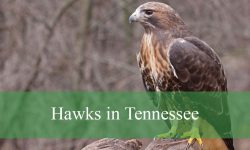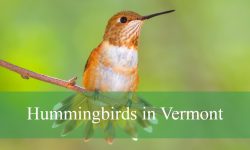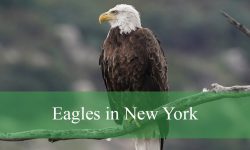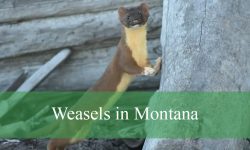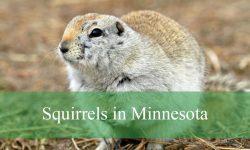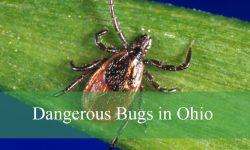Iowa is home to several species of hummingbirds, including both common and rare visitors. These tiny birds are known for their bright colors, fast wing beats, and ability to hover while feeding on nectar.
The Ruby-throated Hummingbird is the most common species in the state, while species like Rufous, Black-chinned, and Calliope Hummingbirds are seen less often during migration. Each species has unique markings and behaviors that make identification possible with careful observation.
This guide covers 6 hummingbird species in Iowa, including identification tips, best times and places to see them, and helpful FAQs for birdwatchers and nature enthusiasts.
Types of Hummingbirds Found in Iowa
Ruby-throated Hummingbird (Archilochus colubris)
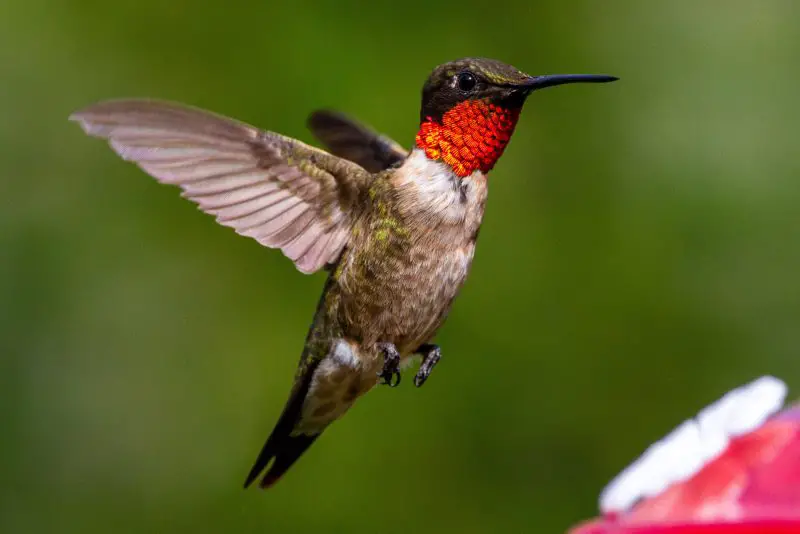
The Ruby-throated Hummingbird is the most common and widely observed hummingbird in Iowa. Adult males are easily identified by their vibrant iridescent ruby-red throat patch, or gorget, which shines brilliantly in sunlight. Females lack the red throat but display a green back and white underparts, making them slightly less conspicuous. Both sexes have slender, slightly curved bills adapted for nectar feeding and tiny, agile wings that allow remarkable hovering abilities.
These hummingbirds are tiny, averaging about 3 to 3.5 inches in length, with a wingspan of 3 to 4 inches. They weigh only 2 to 6 grams, making them one of the smallest birds in North America. Despite their small size, their wing beats are rapid, reaching up to 53 beats per second, producing a humming sound that gives the species its name. Their small size allows them to maneuver skillfully among flowers and feeders, extracting nectar with their long, extendable tongues.
Ruby-throated Hummingbirds are migratory birds, arriving in Iowa in late April to early May and departing by late September. They primarily feed on nectar from tubular flowers, such as bee balm, trumpet creeper, and cardinal flower, but they also consume small insects and spiders for protein. These birds play a critical role in pollination, transferring pollen from flower to flower as they feed.
During breeding season, males perform elaborate aerial displays to attract females, including high-speed dives and rapid zigzag flights. Females build tiny cup-shaped nests, usually on horizontal tree branches, using plant fibers, spider silk, and lichens. Typically, they lay two small, white eggs that hatch in about two weeks. Despite their delicate appearance, Ruby-throated Hummingbirds are resilient and capable of migrating up to 2,000 miles across the Gulf of Mexico to reach wintering grounds in Central America.
Black-chinned Hummingbird (Archilochus alexandri)

The Black-chinned Hummingbird is a rare visitor in Iowa, more commonly found in the western United States. Adult males are identified by their metallic green back, grayish underparts, and distinctive black throat with a small iridescent purple band at the base. Females have a green back, white underparts, and a small patch of purple on the throat, making them less striking than males but still distinguishable. Both sexes have straight, slender bills adapted for nectar feeding.
This species measures about 3.25 inches in length, with a wingspan of approximately 4 inches. Like other hummingbirds, they are incredibly lightweight, generally around 3 to 4 grams, and have rapid wing beats that allow hovering, backward flight, and precise aerial maneuvering. Their flight abilities make them highly effective at feeding from narrow, tubular flowers that are inaccessible to many other bird species.
In Iowa, Black-chinned Hummingbirds are mostly seen during migration, typically in late April or early May, or rarely in fall. Their diet consists of nectar from wildflowers such as penstemon and salvias, along with tiny insects and spiders for protein. Because they are not common in the region, sightings are often noted by avid birdwatchers at feeders or flowering gardens.
During breeding season in their normal western range, males display high-pitched trills and elaborate hovering to attract females. Females build small, cup-shaped nests using plant fibers, moss, and spider silk, usually on protected branches. Although rare in Iowa, these birds are remarkable long-distance travelers capable of adapting to diverse habitats, from desert scrublands to open woodlands.
Rufous Hummingbird (Selasphorus rufus)
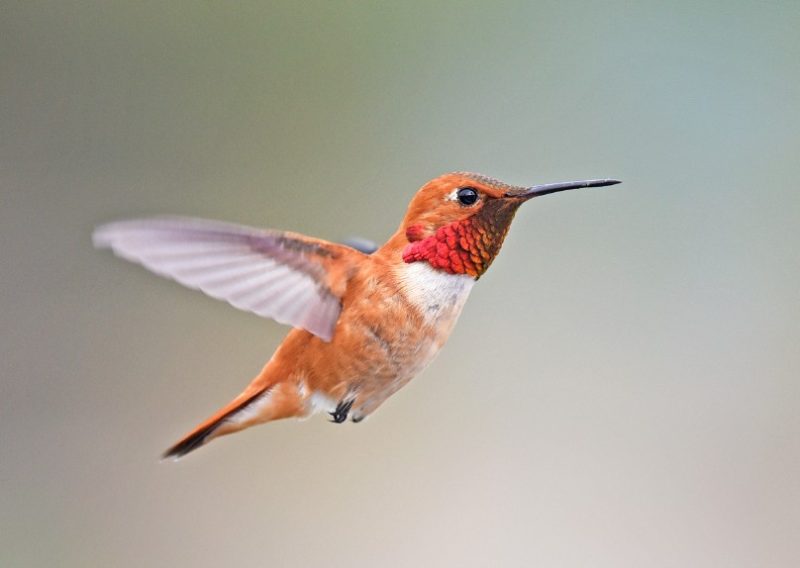
The Rufous Hummingbird is an uncommon migrant in Iowa, known for its fiery reddish-orange plumage. Males are bright orange-red on the back and throat, with a white belly, while females are greenish above with an orange-tinged rump and speckled throat. Their slightly longer, slightly curved bills are well-suited for feeding from a variety of flowers, and their tiny bodies are built for endurance during long migratory journeys.
Rufous Hummingbirds are small, measuring about 3 to 3.5 inches long, with a wingspan of around 4 inches and a weight of 3 to 4 grams. Despite their size, they are extremely aggressive, often chasing away larger hummingbirds from feeders or flower patches. Their rapid wing beats and acrobatic flight allow them to hover effortlessly and feed on nectar with remarkable efficiency.
These birds migrate thousands of miles between their breeding grounds in the Pacific Northwest and wintering areas in Mexico. In Iowa, sightings usually occur in late summer or early fall, often when young birds are dispersing or when vagrant individuals stray from their usual route. They feed primarily on nectar but will also consume insects and spiders for protein, contributing to local pollination.
During the breeding season in their native range, males are highly territorial and perform impressive aerial displays to court females. Females construct small, cup-shaped nests lined with soft plant fibers and covered with lichens for camouflage. The Rufous Hummingbird’s incredible migratory endurance and bold temperament make it one of the most remarkable and sought-after species for birdwatchers visiting Iowa during migration.
Calliope Hummingbird (Selasphorus calliope)
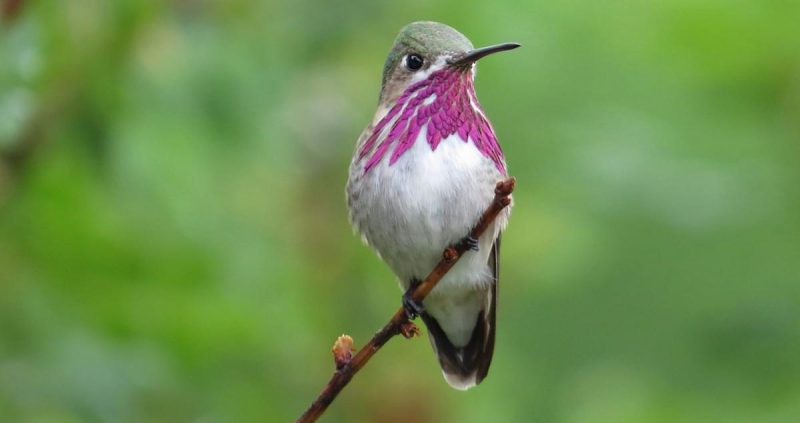
The Calliope Hummingbird is the smallest hummingbird species in North America and a very rare visitor in Iowa. Adult males are recognized by their striking magenta throat streaks against a white chest and green back. Females are more subdued, displaying green upperparts with faint streaking on the throat and white underparts. Both sexes have short, straight bills designed for extracting nectar from small, tubular flowers.
Measuring just 3 inches in length with a wingspan of roughly 4 inches and a weight of only 2.5 to 3 grams, Calliope Hummingbirds are exceptionally lightweight. Their diminutive size allows for incredibly agile flight, including hovering, backward flight, and rapid darting maneuvers. Despite their small stature, they maintain the energetic, high-speed wing beats typical of all hummingbirds, which can exceed 50 beats per second.
In Iowa, these hummingbirds are usually observed during migration in late spring or early fall. Their diet is primarily composed of nectar from small flowers, supplemented by insects and spiders for protein. Due to their rarity in the region, sightings are treasured by birdwatchers and often documented meticulously. Calliope Hummingbirds are known to favor open woodlands, gardens, and shrubby areas where flowers are abundant.
Breeding takes place far west in their normal range, from the northwestern United States to southern Canada. Males perform aerial displays with rapid, high-pitched “chip” calls to attract females. Females build delicate, cup-shaped nests on tree branches using plant fibers, moss, and spider silk, often camouflaged with lichens. Though seldom seen in Iowa, their remarkable endurance and agility make them a fascinating species when observed during migration.
Broad-tailed Hummingbird (Selasphorus platycercus)
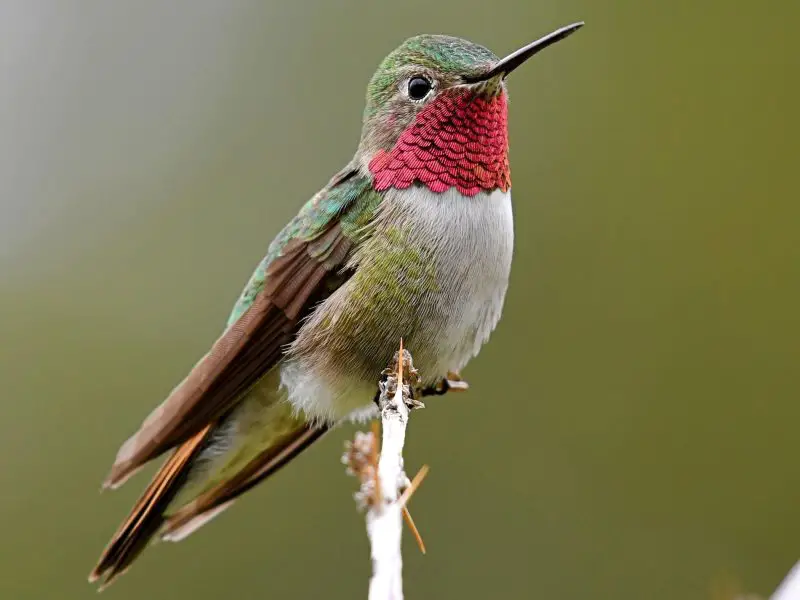
The Broad-tailed Hummingbird is an extremely rare visitor in Iowa, primarily native to western North America. Adult males have a brilliant rose-red throat, green back, and a distinctive broad tail with a slight fork, giving the species its name. Females and juveniles are green above with whitish underparts and lack the vibrant throat coloration. Both sexes feature a straight, slender bill for efficient nectar feeding.
This species averages 3.5 inches in length, with a wingspan of around 4 inches and a weight of 3 to 4 grams. Their flight is highly agile, with rapid wing beats that allow hovering and precision feeding. The broad tail aids in maneuvering through mountain meadows and open woodlands, their preferred habitats in the western United States.
In Iowa, sightings are accidental and generally occur during migration, usually in late summer. Broad-tailed Hummingbirds feed mainly on nectar from wildflowers, including penstemon and columbine, and they supplement their diet with small insects. Birdwatchers cherish these rare encounters due to their vivid coloration and uncommon presence in the region.
Breeding occurs in mountainous areas of the western United States. Males perform aerial displays and make high-pitched chipping sounds to court females. Nesting involves constructing a tiny cup-shaped structure lined with soft plant fibers and camouflaged with lichens or moss. Even though they are rare in Iowa, Broad-tailed Hummingbirds are notable for their boldness and striking appearance when observed.
Allen’s Hummingbird (Selasphorus sasin)
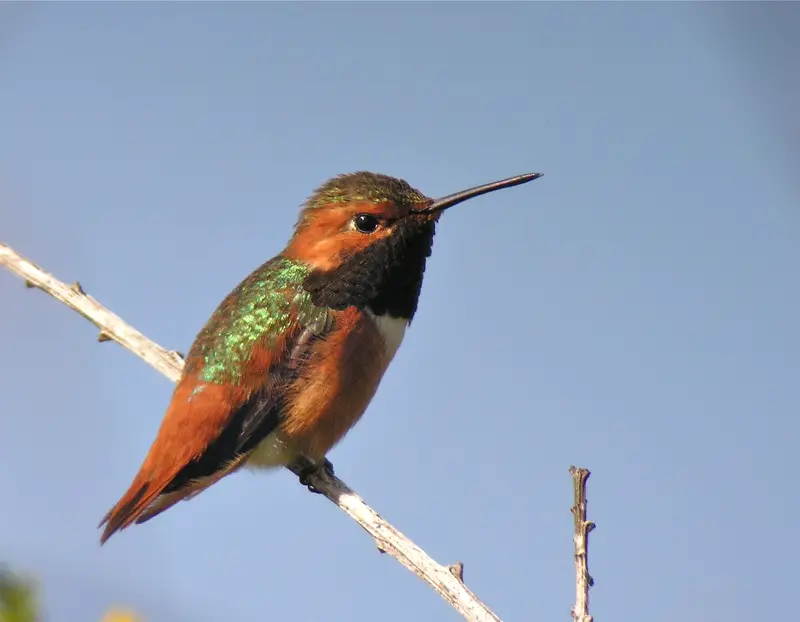
Allen’s Hummingbird is an accidental and extremely rare visitor in Iowa, native to the coastal regions of California. Adult males exhibit bright orange-red throats, green backs, and orange flanks, while females are green above with orange on the sides and a pale underbelly. Their short, straight bills are perfectly adapted for nectar feeding, and their compact bodies make them agile flyers.
These hummingbirds measure approximately 3 inches in length, with a wingspan of about 4 inches and a weight of 3 grams. Their small size allows them to hover with remarkable precision, dart quickly between flowers, and even fly backward when feeding. Wing beats are extremely rapid, producing the characteristic humming sound that defines the species.
In Iowa, Allen’s Hummingbirds are typically seen as vagrants during migration, often in late summer or fall. Their diet consists mainly of nectar, supplemented with small insects and spiders. Due to their rarity, sightings are extremely exciting for birdwatchers and often prompt photographic documentation.
Breeding occurs along the California coast, where males perform aerial displays to court females. Females build small, delicate nests using plant fibers, spider silk, and lichens for camouflage. While Iowa is far outside their usual range, these birds demonstrate remarkable migratory capabilities and adaptability, making each sighting a noteworthy event for local birding enthusiasts.
Best Time and Places to Observe Hummingbirds in Iowa
Hummingbirds in Iowa are most commonly observed during spring migration from late April to June and late summer to early fall, typically August through September. During these periods, birds are actively feeding and resting along their migratory routes. Gardens with nectar-rich flowers such as bee balm, trumpet vine, cardinal flower, penstemon, and columbine are excellent spots to attract them. Backyard feeders filled with sugar water are also highly effective, especially for Ruby-throated Hummingbirds, which are the most common species in the state.
Open woodland edges, riverbanks, botanical gardens, and suburban areas with flowering shrubs provide ideal observation points. Rare species such as Black-chinned, Rufous, Calliope, Broad-tailed, and Allen’s Hummingbirds are usually seen as vagrants or during migration, so sightings are unpredictable. Birdwatchers may increase their chances by maintaining continuous nectar sources, planting bright red or orange tubular flowers, and keeping cats or other predators away from feeding areas.
Ruby-throated Hummingbirds are the most frequent visitors, easily attracted to both natural flowers and feeders from late April through September, peaking in May and June. Rufous Hummingbirds and other rare vagrants are most often observed in late summer or early fall, while Black-chinned and Calliope Hummingbirds may appear in late spring or early fall. Broad-tailed and Allen’s Hummingbirds are accidental visitors, making any sighting noteworthy for enthusiasts.
Providing abundant nectar sources not only benefits local hummingbirds but also supports pollination of flowers in gardens and natural areas. Observers should watch for the birds’ rapid wing beats, hovering ability, and territorial behavior around feeders, which are characteristic of all hummingbird species. Documenting rare sightings, photographing them if possible, and reporting to local birding groups can help contribute to regional knowledge of hummingbird migration patterns.
FAQs About Hummingbirds in Iowa
What is the most common hummingbird in Iowa?
The Ruby-throated Hummingbird is the most frequently observed species in Iowa. It appears regularly from late April through September and is commonly attracted to backyard feeders and flowering gardens.
When is the best time to see hummingbirds in Iowa?
Hummingbirds are most active and visible during spring migration (late April to June) and late summer to early fall (August to September). Peak observation months for the Ruby-throated Hummingbird are May and June, while rare species are generally seen in late summer or early fall.
Do hummingbirds visit feeders in Iowa?
Yes, most species, particularly Ruby-throated Hummingbirds, readily visit sugar water feeders. Providing a mix of four parts water to one part white sugar, without red dye, can attract these birds efficiently. Feeders should be cleaned regularly to prevent mold and bacterial growth.
Are there any rare hummingbirds in Iowa?
Yes, several species are considered rare visitors. Black-chinned, Rufous, Calliope, Broad-tailed, and Allen’s Hummingbirds are usually seen only during migration or as accidental vagrants. Observing these species is uncommon and often highly prized by birdwatchers.
What flowers attract hummingbirds in Iowa?
Hummingbirds prefer tubular, brightly colored flowers, particularly red, orange, or pink. Popular choices include bee balm, trumpet creeper, cardinal flower, columbine, and penstemon. Planting a variety of these flowers increases the chances of attracting both common and rare species.
Can I attract rare hummingbirds to my garden?
While attracting rare hummingbirds cannot be guaranteed, planting a variety of nectar-rich flowers, offering feeders, and maintaining a safe, predator-free environment can improve the likelihood. Observers should document unusual sightings and report them to local birding groups to help track migration patterns.

